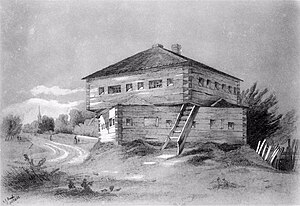Sherbourne Blockhouse
Following the Upper Canada Rebellion of 1837 Lieutenant Governor of Upper Canada Sir George Arthur directed the construction of a Sherbourne Blockhouse, and a ring of six other blockhouses -- to guard the approaches to Toronto in case there was another rebellion.[1][2][3][4] The Sherbourne Blockhouse was located at the northern end of Sherbourne Street, at the current intersection with Bloor, just south of the Rosedale Ravine.
The blockhouses were two stories tall, and designed to accommodate up to 44 soldiers.[3] The two stories were at 45 degrees to one another—a design intended to make it easier to observe in all directions.
Construction of the blockhouses was budgeted at 330 British Pounds.[3] They were completed in 1838. By 1850 they were staffed by a skeleton crew of former soldiers, who served as caretakers. The Spadina Blockhouse was demolished sometime before 1854. The Yonge Blockhouse was demolished in 1865. The Sherbourne Blockhouse was demolished in 1875.[1] Numerous sketches of it have survived to the current day.[3]
Reverences
- ↑ Jump up to: 1.0 1.1 Yorkville in pictures: 1853 to 1883, Toronto Public Library. “After the 1837 Rebellion Sir George Arthur had the Fort enlarged and a ring of blockhouses built to guard the chief roads leading into Toronto. By 1838 there were seven such structures standing in the Toronto region: No.1 was the New Barracks. No. 2 was at College and Spadina. No. 3 on Bloor near today's University Avenue, No.4 at Yonge Street and Belmont, No.5 at Bloor and Sherbourne, No.6 on the Don River between College and Bloor. and No.7 at the junction of Lot (Queen Street) and King Streets. The Bloor and Sherbourne Blockhouse stood until 1875 and may be glimpsed in the background of the picture of Bloor's Brewery.”
- ↑ Charles Sauriol (1981). Remembering the Don: A Rare Record of Earlier Times Within the Don River Valley. Dundurn. ISBN 9781459713611. Retrieved on 2013-03-05. “The Sherbourne Street blockhouse stood at the head of Sherbourne Street on an exact line with Bloor Street. It was part of a system of defense to protect the city from the north during the rebellion of 1837.”
- ↑ Jump up to: 3.0 3.1 3.2 3.3 Stephen A. Otto. On The Many Sketches Of Toronto Blockhouses, Friends of Fort York, 2001-06-30.
- ↑ Marinell Ash, Elizabeth Hulse. Thinking with Both Hands: Sir Daniel Wilson in the Old World and the New, University of Toronto Press, 1999, pp. 241, 262. Retrieved on 2013-03-18. “At the top of Sherbourne Street on the edge of the ravine there stood then an old blockhouse, built originally for defense against hostile Indians who might be approaching Toronto from the Don Valley by way of the subsidiary ravine. In this congenial setting the Wilsons would live until the early 1880s.”
